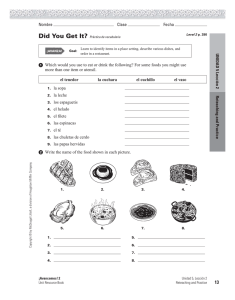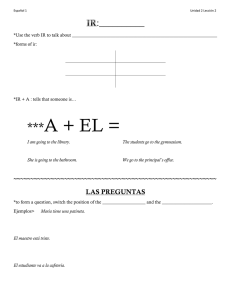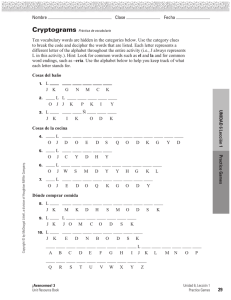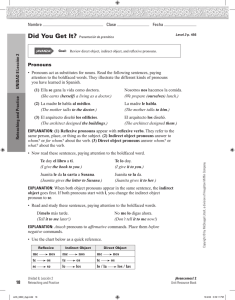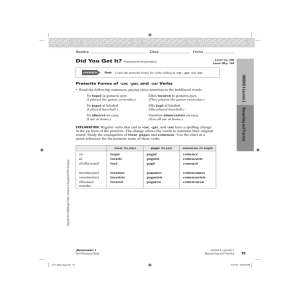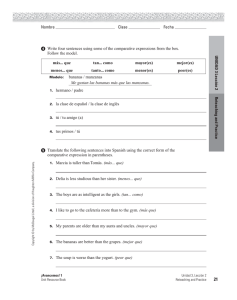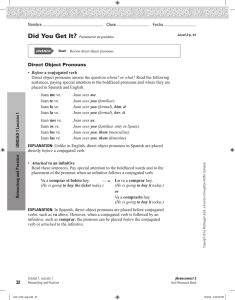1 The House
Anuncio
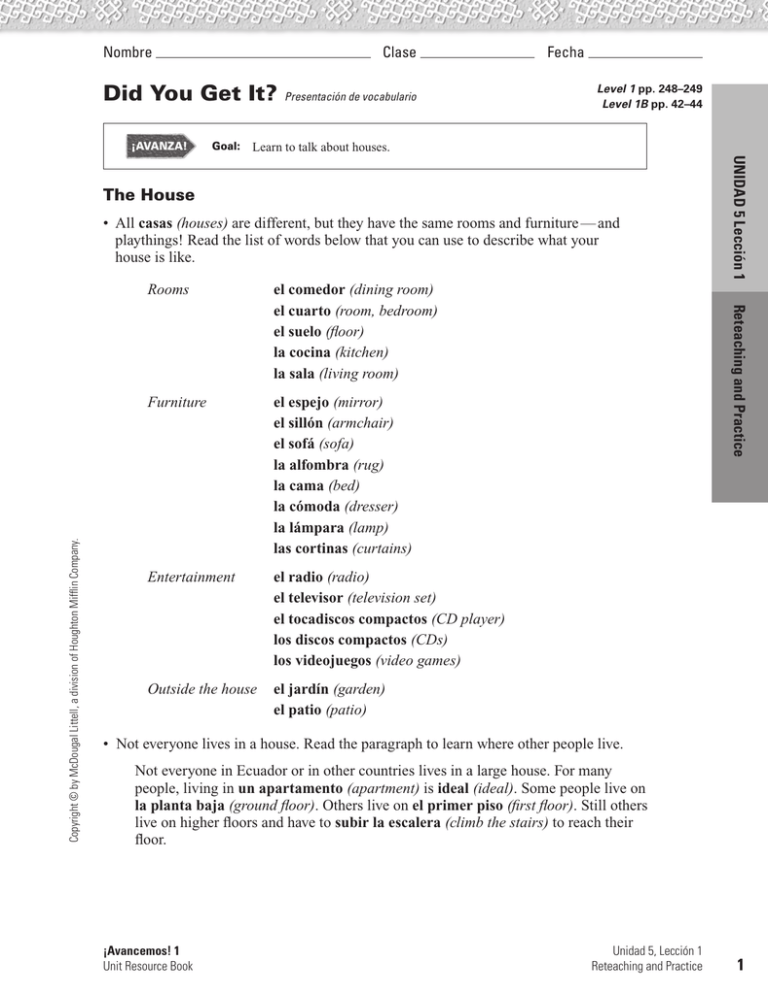
Nombre Clase Did You Get It? ¡AVANZA! Goal: Presentación de vocabulario Fecha Level 1 pp. 248–249 Level 1B pp. 42–44 Learn to talk about houses. Rooms el comedor (dining room) el cuarto (room, bedroom) el suelo (floor) la cocina (kitchen) la sala (living room) Furniture el espejo (mirror) el sillón (armchair) el sofá (sofa) la alfombra (rug) la cama (bed) la cómoda (dresser) la lámpara (lamp) las cortinas (curtains) Entertainment el radio (radio) el televisor (television set) el tocadiscos compactos (CD player) los discos compactos (CDs) los videojuegos (video games) Outside the house el jardín (garden) el patio (patio) Reteaching and Practice Copyright © by McDougal Littell, a division of Houghton Mifflin Company. • All casas (houses) are different, but they have the same rooms and furniture — and playthings! Read the list of words below that you can use to describe what your house is like. UNIDAD 5 Lección 1 The House • Not everyone lives in a house. Read the paragraph to learn where other people live. Not everyone in Ecuador or in other countries lives in a large house. For many people, living in un apartamento (apartment) is ideal (ideal). Some people live on la planta baja (ground floor). Others live on el primer piso (first floor). Still others live on higher floors and have to subir la escalera (climb the stairs) to reach their floor. ¡Avancemos! 1 Unit Resource Book Unidad 5, Lección 1 Reteaching and Practice 1 Nombre Clase Did You Get It? Goal: Learn to talk about houses. b. c. d. e. f. g. h. i. j. 1. el videojuego 6. la alfombra 2. el radio 7. el sofá 3. el espejo 8. las cortinas 4. la lámpara 9. disco compacto 5. el tocadiscos compactos 1. 2. 3. 4. escuchar música? las cortinas la cama descansar? el espejo leer? la cocina 1. el radio 2. las cortinas el sofá 3. la alfombra el televisor 3 Where do you normally go to… la lámpara ver programas de televisión? la cama el televisor el suelo Unidad 5, Lección 1 Reteaching and Practice 10. 4. dormir? el cuarto la cocina el suelo comer? el radio el espejo el comedor cocinar? la cocina el jardín el cuarto leer el periódico? la sala el espejo el radio ¡Avancemos! 1 Unit Resource Book Copyright © by McDougal Littell, a division of Houghton Mifflin Company. a. 2 What do you normally use to… 2 Level 1 p. 250 Level 1B p. 45 Práctica de vocabulario 1 Match the following. Reteaching Reteaching and and Practice Practice UNIDAD 5 Lección 1 ¡AVANZA! Fecha Nombre Clase Fecha 4 Choose a word from the box to explain where these people are. You can use each la sala el comedor la cocina Juan come. 2. Antonio descansa. 3. Julio prepara una barbacoa. 4. Eva planta flores (flowers). 5. El señor Tobar lee el periódico. 6. Ana escucha un disco compacto. 7. Beatriz toca el piano. 8. Nosotros miramos la televisión. 9. Yo como cereal. 10. el patio el cuarto Reteaching and Practice 1. el jardín UNIDAD 5 Lección 1 place more than one time. El chico habla por teléfono. 5 Choose a word from the box to complete each sentence. Copyright © by McDougal Littell, a division of Houghton Mifflin Company. cuarto alfombras comedor 1. Uso una 2. Preparo la comida en la 3. Siempre estudio en mi 4. Voy al 5. Para escuchar música, uso el 6. Tenemos unas tocadiscos compactos lámpara cocina para leer. . . para comer. . bonitas en el suelo. 6 Write a short paragraph describing your house and some of the things in it. Modelo: ¡Avancemos! 1 Unit Resource Book Mi casa es grande. Tiene tres pisos. También tiene un jardín muy bonito. En la sala hay un televisor. En mi cuarto hay otro televisor. También hay un tocadiscos compactos. Miro la televisión y escucho música en mi cuarto. Unidad 5, Lección 1 Reteaching and Practice 3 Nombre Clase Did You Get It? Goal: Level 1 p. 253 Level 1B p. 48 Presentación de gramática Learn the differences between ser and estar. Ser and estar • There are two verbs in Spanish that mean to be. Read the sentences below, paying attention to the boldfaced verb in each. As you read each set of sentences, think about what they are about. I am from the United States. The girls are nice. Raúl is an actor. It is one o’clock. The CDs are Alex’s. It is January 1st. origin trait profession time possession date Yo soy de Estados Unidos. Las chicas son simpáticas. Raúl es actor. Es la una. Los discos compactos son de Alex. Es el primero de enero. • Now read this set of sentences. I am in Spanish class. The boys are fine. The girls are happy. location physical condition emotional condition Yo estoy en la clase de español. Los chicos están bien. Las chicas están contentas. EXPLANATION: Ser and estar both mean to be. There are six situations when you use ser: (1) to indicate origin, or where someone is from; (2) to describe personal traits or physical characteristics; (3) to indicate professions; (4) to tell time; (5) to indicate possession; and (6) to give the date. There are three situations when you use estar: (1) to say where someone or something is; (2) to describe a physical condition (usually health-related states); and (3) to describe an emotional condition (usually feelings). 4 Unidad 5, Lección 1 Reteaching and Practice ¡Avancemos! 1 Unit Resource Book Copyright © by McDougal Littell, a division of Houghton Mifflin Company. Reteaching and Practice UNIDAD 5 Lección 1 ¡AVANZA! Fecha Nombre Clase Did You Get It? ¡AVANZA! Goal: Fecha Level 1 pp. 254–255 Level 1B pp. 49–51 Práctica de gramática Learn the differences between ser and estar. UNIDAD 5 Lección 1 1 Answer the questions using the model as a guide. Modelo: ¿De dónde es Juan? (de Quito) Juan es de Quito. ¿Cómo es Luis? (simpático) 2. ¿De dónde es Andrea? (de Guayaquil) 3. ¿Cómo es el libro? (interesante) 4. ¿Cómo son los chicos? (inteligentes) 5. ¿Cómo es la clase de español? (divertida) 6. ¿De quién es el disco compacto? (de Jorge) 7. ¿Qué hora es? (1:30) 8. ¿Qué fecha es hoy? (4 de enero) 9. ¿Cómo son los chicos? (altos) 10. Reteaching and Practice 1. ¿Qué es la señora López? (maestra) Copyright © by McDougal Littell, a division of Houghton Mifflin Company. 2 Answer the questions following the model. Modelo: ¿Dónde está Juan? (en la escuela) Juan está en la escuela. 1. ¿Cómo está Linda? (bien) 2. ¿Dónde está Quito? (en Ecuador) 3. ¿Cómo están Paco y Ana? (cansados) 4. ¿Dónde está París? (en Francia) 5. ¿Cómo está Pedro? (triste) 3 In the following sentences, which verb would you use, ser or estar? 1. María is tall. 6. Eduardo is studious. 2. Tomás is worried. 7. My sister is pretty. 3. I am tired. 8. My mother is in the car. 4. They are in the garden. 9. Anita is a brunette. 5. We are students. ¡Avancemos! 1 Unit Resource Book 10. I am from Spain. Unidad 5, Lección 1 Reteaching and Practice 5 Nombre Clase Fecha 1. Nosotros en la sala. 2. La lámpara de Quito. 3. Los jardines bonitos. 4. Va a su cuarto porque 5. Ellos cansado. en la cocina. las seis de la tarde. 6. 7. Mi casa 8. Luis al lado de su casa. alto. 5 Translate the following sentences into Spanish. 1. The fruit is from Florida. 2. My brothers are in the kitchen. 3. María’s dog is lazy. 4. Mr. Velázquez is a teacher. 5. María is studious. 6. Today is July 4th. 7. It is three o’clock. 6 Use complete sentences to answer these questions about you, your house, and your Spanish class. Sobre ti 1. ¿Cómo eres? 2. ¿De dónde eres? 3. ¿Cómo estás hoy? 4. ¿Dónde estás ahora? Tu casa 5. ¿Cómo es tu casa? 6. ¿Dónde está tu casa? Tu clase de español 6 7. ¿Cómo es tu clase de español? 8. ¿A qué hora es tu clase de español? Unidad 5, Lección 1 Reteaching and Practice ¡Avancemos! 1 Unit Resource Book Copyright © by McDougal Littell, a division of Houghton Mifflin Company. Reteaching and Practice UNIDAD 5 Lección 1 4 Complete each sentence with the correct form of ser or estar. Nombre Clase Did You Get It? ¡AVANZA! Goal: Fecha Level 1 p. 258 Level 1B p. 54 Presentación de gramática Learn ordinal numbers. EXPLANATION: As in English, ordinal numbers in Spanish are placed before nouns. Ordinal numbers agree in gender and number with the nouns they describe. In the first sentence, primera agrees with the feminine noun casa. In the second sentence, sexto agrees with the masculine noun piso. • Now read these sentences, paying attention to the boldfaced words. Enero es el primer mes del año. (January is the first month of the year.) Marzo es el tercer mes del año. (March is the third month of the year.) Reteaching and Practice • Ordinal numbers indicate position (first, second, third) in a series or the order of items. Read the sentences below, paying attention to the boldfaced words, and to their placement in the sentences. Magda vive en la primera casa. (Magda lives in the first house.) Andrés vive en el sexto piso. (Andrés lives on the sixth floor.) UNIDAD 5 Lección 1 Ordinal numbers Copyright © by McDougal Littell, a division of Houghton Mifflin Company. EXPLANATION: Primero and tercero drop the o before a masculine singular noun, such as mes. Study the chart below and use it as a quick reference for ordinal numbers. Ordinal Numbers primero(a) (first) primer (before a masc. sing. noun) segundo(a) (second) tercero(a) (third) tercer (before a masc. sing. noun) cuarto(a) (fourth) quinto(a) (fifth) ¡Avancemos! 1 Unit Resource Book sexto(a) (sixth) séptimo(a) (seventh) octavo(a) (eighth) noveno(a) (ninth) décimo(a) (tenth) Unidad 5, Lección 1 Reteaching and Practice 7 Nombre Clase Did You Get It? Reteaching and Practice UNIDAD 5 Lección 1 ¡AVANZA! Goal: Fecha Level 1 pp. 259–260 Level 1B pp. 55–57 Práctica de gramática Learn ordinal numbers. 1 On which floor does each person live? Complete the sentences using the model as a guide. Modelo: Antonio vive en el cuarto piso. (4) 1. Lupe vive en el piso. (1) 2. Marisa vive en el 3. Óscar y María viven en el 4. La familia Suárez vive en el 5. Mi amigo vive en el 6. La maestra de español vive en el 7. Los chicos viven en el 8. Mis abuelos viven en el 9. Pilar vive en el piso. (9) piso. (6) piso. (3) piso. (5) piso. (7) piso. (2) piso. (10) piso. (8) 2 Who is wearing what? Follow the model to answer the questions. 8 ¿Quién lleva un sombrero? La sexta persona lleva un sombrero. 1. ¿Quién lleva pantalones cortos? 2. ¿Quién lleva una chaqueta? 3. ¿Quién lleva una camiseta? 4. ¿Quién lleva un vestido? 5. ¿Quién lleva un traje? 6. ¿Quién lleva jeans? 7. ¿Quién lleva una blusa? 8. ¿Quién lleva un gorro? Unidad 5, Lección 1 Reteaching and Practice Copyright © by McDougal Littell, a division of Houghton Mifflin Company. Modelo: ¡Avancemos! 1 Unit Resource Book Nombre Clase Fecha 3 Look at the picture and answer the following questions. UNIDAD 5 Lección 1 Ramón Pilar Gloria Andrés Alex Reteaching and Practice Cristina Julia Isabel Jaime Copyright © by McDougal Littell, a division of Houghton Mifflin Company. Arturo To which floor do you go to visit each person? Follow the model. Modelo: ¿A Jaime? Voy al segundo piso. 1. ¿a Álex? 2. ¿a Arturo? 3. ¿a Isabel? 4. ¿a Ramón? 5. ¿a Cristina? 6. ¿a Gloria? 7. ¿a Pilar? 8. ¿a Julia? 9. ¿a Andrés? 4 Translate the following sentences into Spanish. 1. I live in the fourth house on Elm Street. 2. The second book is Margarita’s. ¡Avancemos! 1 Unit Resource Book Unidad 5, Lección 1 Reteaching and Practice 9 Nombre Clase Fecha Level 1 p. 250 Level 1B p. 45 ¿Recuerdas? ue • A common verb stem change in the present tense is o to ue. One of the verbs that has this stem change is poder. Study the following sentences, noting that the stem change occurs in all forms except nosotros(as) and vosotros(as). Yo puedo descansar. (I can rest.) Tú puedes correr. (You can run.) Lola puede escribir un correo electrónico. (Lola can write an e–mail.) Aldo y yo podemos hablar por teléfono. (Aldo and I can talk on the telephone.) Anastasia y tú podéis almorzar. (Anastasia and you can eat lunch.) ¡Todos pueden bailar! (Everyone can dance!) • Other verbs that follow the same pattern as poder include dormir (to sleep), almorzar (to lunch), costar (to cost), encontrar (to find), and volver (to return). Práctica 1 Complete each sentence with the correct form of the verb in parentheses. 1. ¿ 2. Yo 3. Roberto y yo 4. Vosotros a las doce y media. (almorzar) 5. ¿Cuánto la lámpara? (costar) 6. Lupe 7. Nosotros 8. ¿ 9. Yo 10. tú la escalera para subir al segundo piso? (encontrar) bajar al primer piso si quieres. (poder) en casa de José. (dormir) del cine a las nueve y media. (volver) una cómoda bonita para el cuarto. (encontrar) nosotros subir la escalera para llegar al tercer piso? (poder) Tú y Linda en el nuevo restaurante. (almorzar) mucho generalmente. (dormir) 2 Write sentences using the verbs and subjects given. 10 1. (almorzar) Yo 2. (poder) Tú 3. (volver) Mis amigos 4. (dormir) Mis padres 5. (encontrar) Mi mejor amigo Unidad 5, Lección 1 Reteaching and Practice ¡Avancemos! 1 Unit Resource Book Copyright © by McDougal Littell, a division of Houghton Mifflin Company. Reteaching and Practice UNIDAD 5 Lección 1 Stem-changing verbs o Nombre Clase Fecha Level 1 p. 254 Level 1B p. 49 ¿Recuerdas? Location words UNIDAD 5 Lección 1 • Review the following expressions to talk about location in Spanish. lejos de (far from) cerca de (near to) delante de (in front of) detrás de (behind) encima de (on top of) debajo de (under) al lado de (next to) dentro de (inside of) Copyright © by McDougal Littell, a division of Houghton Mifflin Company. Use the location words above to describe where the following items are in relation to each other. Follow the model. Modelo: la lámpara / la mesa La lámpara está encima de la mesa. 1. la alfombra / el sofá 2. el sillón / la ventana 3. las cortinas / la ventana 4. la computadora / el escritorio 5. el sillón / el sofá 6. el escritorio / la sala 7. el espejo / la ventana 8. la lámpara / el sillón 9. el sofá / la televisión ¡Avancemos! 1 Unit Resource Book Unidad 5, Lección 1 Reteaching and Practice Reteaching and Practice Práctica 11 Nombre Clase Fecha Level 1 pp. 255, 259 Level 1B pp. 50, 55 ¿Recuerdas? • Review and study the following names of colors in Spanish. amarillo(a) (yellow) marrón (pl., marrones) (brown) anaranjado(a) (orange) negro(a) (black) azul (pl., azules) (blue) rojo(a) (red) blanco(a) (white) verde (green) Clothing • Review the following Spanish words for clothes. Para los chicos la camisa (shirt) Para todos el gorro (winter hat) el sombrero (hat) la camiseta (T-shirt) la chaqueta (jacket) los calcetines (socks) los jeans (jeans) los pantalones (pants) los pantalones cortos (shorts) los zapatos (shoes) Para las chicas el vestido (dress) la blusa (blouse) Práctica Complete the translation of the following sentences. The first one is done for you. 1. Andrés lleva (blue pants) pantalones azules 2. Los chicos llevan (black jeans) . 3. Yo llevo (a yellow dress) . 4. En el verano, llevas (a white T-shirt) . 5. Tú llevas (a green blouse) . 6. En el invierno, llevamos (black hats) . 7. Cuando hace frío, lleváis (a brown jacket) . 8. Nosotros llevamos (red shorts) . 9. Cuando hace calor, él lleva (a white hat) . ¡Jorge siempre lleva (orange shoes) ! 10. 12 . Unidad 5, Lección 1 Reteaching and Practice ¡Avancemos! 1 Unit Resource Book Copyright © by McDougal Littell, a division of Houghton Mifflin Company. Reteaching and Practice UNIDAD 5 Lección 1 Colors Nombre Clase Did You Get It? ¡AVANZA! Goal: Fecha Presentación de vocabulario Level 1 pp. 272–273 Level 1B pp. 70–72 Learn how to talk about planning a party. Copyright © by McDougal Littell, a division of Houghton Mifflin Company. Reteaching and Practice • There are many things to do when you want to to give a party (dar una fiesta). If it’s a surprise party (una fiesta de sorpresa), you first need to ask everyone to keep the secret (el secreto). Then you must clean (hay que limpiar) the house before the guests (los invitados) arrive. It’s probably best to make a list of chores (los quehaceres) that need to be done to get the house in order. After all, you wouldn’t want to invite people to a house that is dirty (sucia)! Here are some suggestions to study. cortar el césped (to cut the grass) hacer la cama (to make the bed) pasar la aspiradora (to vacuum) planchar la ropa (to iron) limpiar la cocina (to clean the kitchen) lavar los platos (to wash the dishes) barrer el suelo (to sweep the floor) sacar la basura (to take out the trash) UNIDAD 5 Lección 2 The surprise party • Once the house is limpia (clean) and in order, you should decorate it (debes decorarla). Your friends will probably volunteer to help (ayudar) because decorating is fun. The decorations (las decoraciones) can include streamers and balloons (globos). It’s important to put up the decorations (poner las decoraciones) and set the table (poner la mesa) before starting to cook (cocinar). And don’t forget to feed the dog (darle de comer al perro). You certainly don’t want him to eat the party food while you’re in the living room putting together the gift (el regalo) for your friend. • After you wrap (envolver) your friend’s gift with gift paper (el papel de regalo), you can relax, but not for too long. • Your friends like to come (venir) early and celebrate (celebrar) right away. So, when the guest of honor arrives, be ready to say (decir) «¡Sorpresa!» and to begin to dance (bailar) and sing (cantar), and eat the food that you just prepared (acabas de preparar). That is, if you remembered to feed the dog! ¡Avancemos! 1 Unit Resource Book Unidad 5, Lección 2 Reteaching and Practice 13 Nombre Clase Did You Get It? Goal: Level 1 p. 274 Level 1B p. 73 Práctica de vocabulario Learn how to talk about planning a party. 1 What do you do when… 1. there are crumbs on the kitchen floor? barrer el suelo cortar el césped 2. the carpet is dirty? hacer la cama pasar la aspiradora 3. the dishes are piled high in the sink? sacar la basura lavar los platos 4. the grass is overgrown? cortar el césped limpiar la cocina the bed is unmade? sacar la basura hacer la cama the trash is overflowing? limpiar la cocina sacar la basura 5. 6. 7. the clothes are wrinkled? cortar el césped planchar la ropa 2 Write a sentence explaining what one should do based on each picture. Follow the model. Hay que pasar la aspiradora. Modelo: 1. 14 2. 3. 4. 5. 6. 1. . 2. . 3. . 4. . 5. . 6. . Unidad 5, Lección 2 Reteaching and Practice ¡Avancemos! 1 Unit Resource Book Copyright © by McDougal Littell, a division of Houghton Mifflin Company. Reteaching and Practice UNIDAD 5 Lección 21 ¡AVANZA! Fecha Nombre Clase Fecha 3 Complete the paragraphs with words and expressions from the box. celebrar cocinar dar una fiesta decir envolver la aspiradora bailar las decoraciones limpia globos los invitados los platos sorpresa venir , pero es 1. ! a las siete. Tenemos . Mi familia va a Copyright © by McDougal Littell, a division of Houghton Mifflin Company. Mi hermano Juan va a lavar 7. , barrer el suelo y pasar 8. . Mi hermana Luisa va a poner 9. . Ella tiene 10. de muchos colores. Mi mamá va a 11. una buena comida y mi papá va a hacer el pastel. ¿Y yo? Yo voy a 12. los regalos para Marisa. Cuando llega Marisa, todos vamos a 13. y «¡Feliz cumpleaños!» Vamos a 14. muchos platos y dulces deliciosos. También vamos a y cantar. Reteaching and Practice Hoy es el cumpleaños de Marisa. Vamos a un secreto. Sí, ¡es una fiesta de 2. 3. van a 4. que trabajar mucho. La casa está sucia y debe estar 5. 6. . UNIDAD 5 Lección 2 ayudar «¡Sorpresa!» con muchas cosas ricas y 15. 4 Choose a logical response for each statement in the left column. 1. La cocina está sucia. a. Voy a darle de comer ahora. 2. Voy a poner las decoraciones. b. Sí, ¿dónde está el papel? 3. El perro tiene hambre. c. Voy a limpiarla. 4. Hoy es mi cumpleaños. d. ¡Feliz cumpleaños! 5. ¿Quieres envolver el regalo? e. Sí, ¿dónde están los platos? 6. ¿Te gusta poner la mesa? f. Gracias. Aquí tienes los globos. 5 Use Hay que + infinitive to write, in order, five things one must do to prepare for a party. 1. 2. 3. 4. 5. ¡Avancemos! 1 Unit Resource Book Unidad 5, Lección 2 Reteaching and Practice 15 Nombre Clase Did You Get It? Goal: Level 1 p. 277 Level 1B p. 76 Presentación de gramática Learn the forms of more irregular verbs. More irregular verbs • Read and study the following sentences, paying attention to the boldfaced words. Yo digo la verdad. (I say the truth.) Tú dices que es una fiesta sorpresa. (You say that it’s a surprise party.) Ella dice que es un secreto. (She says that it’s a secret.) Ana y tú decís que os gustan los regalos. (Ana and you say that you like the gifts.) ¡Todos dicen que es una buena fiesta! (Everyone says that it is a good party!) Nosotros decimos que la decoraciones son divertidas. (We say that the decorations are fun.) • Study these sentences, paying attention to the boldfaced verbs. Yo vengo a las seis. (I come at six o’clock.) Tú vienes a las seis y media. (You come at 6:30.) ¿A qué hora viene él? (What time does he come?) Nosotros venimos a las siete. (We come at seven o’clock.) Paco y tú venís a las siete y cuarto. (Paco and you come at 7:15.) ¡Todos vienen temprano! (All come early!) EXPLANATION: Decir and venir have several irregular forms. Only the nosotros(as) and vosotros(as) forms are regular. Use the chart below as a quick reference for the conjugation of decir and venir in the present tense. Infinitive yo tú usted él/ella nosotros(as) vosotros(as) ellos(as)/ustedes decir (to say, to tell) digo (I say) dices (you say) dice (you say) dice (he/she says) decimos (we say) decís (you say) dicen (they/you say) venir (to come) vengo (I come) vienes (you come) viene (you come) viene (he/she comes) venimos (we come) venís (you come) vienen (they/you come) • Read the following sentences, paying attention to the boldfaced words. Doy una fiesta de cumpleaños. (I am giving a birthday party.) ¿Pongo la mesa ahora? (Do I set the table now?) Salgo para la fiesta a las siete. (I am leaving for the party at seven o’clock.) ¿Traigo los discos compactos a la fiesta? (Do I bring the CDs to the party?) EXPLANATION: The verbs dar, poner, salir, and traer are irregular only in the yo form. 16 Unidad 5, Lección 2 Reteaching and Practice ¡Avancemos! 1 Unit Resource Book Copyright © by McDougal Littell, a division of Houghton Mifflin Company. Reteaching and Practice UNIDAD 5 Lección 2 ¡AVANZA! Fecha Nombre Clase Did You Get It? ¡AVANZA! Goal: Fecha Level 1 pp. 278–279 Level 1B pp. 77–79 Práctica de gramática Learn the forms of more irregular verbs. UNIDAD 5 Lección 2 1 Write the correct form of decir for each subject. yo tú los estudiantes Pilar vosotras Reteaching and Practice 2 Write the correct form of venir for each subject. vosotros la maestra ustedes yo Rodrigo y yo Copyright © by McDougal Littell, a division of Houghton Mifflin Company. 3 Write the correct form of traer for each subject. vosotras usted tú ellos yo 4 Write the correct form of poner for each subject. yo tú usted usted Anita y yo 5 Write the correct form of dar for each subject. tú usted ellos Anita y yo yo 6 Write the correct form of salir for each subject. nosotros ellos usted tú yo ¡Avancemos! 1 Unit Resource Book Unidad 5, Lección 2 Reteaching and Practice 17 Nombre Clase Fecha Reteaching and Practice UNIDAD 5 Lección 2 7 Write sentences describing who does what for the party. Follow the model. Modelo: Ariana / venir / a las seis para ayudar Ariana viene a las seis para ayudar. 1. tú / salir / temprano de casa 2. mi hermana / poner / la mesa 3. yo / poner / los globos en la sala 4. los invitados / venir / a las siete 5. todos / decir / «¡Feliz cumpleaños!» 6. nosotros / dar / muchos regalos venir salir traer dar decir poner Ana: Félix, tú sabes que hoy una fiesta para Elena. ¿Cuándo con las decoraciones? Félix: Ana: ¿ de mi casa en diez minutos. Llego en media hora. los globos? Félix: Sí, los llevo. ¿Y tú, Ana, ¿qué haces? Ana: Yo preparo la comida y Félix: Y cuando «¡Sorpresa!» y le la mesa. Elena, todos nosotros los regalos. 9 Write sentences describing four things you do to prepare for a party. Follow the model. Modelo: salir para comprar un regalo 18 Salgo para comprar un regalo. 1. traer los discos compactos . 2. poner las decoraciones . 3. decir «¡Sorpresa!» . 4. dar un regalo . Unidad 5, Lección 2 Reteaching and Practice ¡Avancemos! 1 Unit Resource Book Copyright © by McDougal Littell, a division of Houghton Mifflin Company. 8 Complete the conversation with the correct form of the appropriate verb. Nombre Clase Did You Get It? ¡AVANZA! Goal: Fecha Level 1 p. 282 Level 1B p. 82 Presentación de gramática Learn how to use affirmative tú commands. EXPLANATION: Regular affirmative tú commands use the él/ella/usted form in the present tense. Study the following chart of affirmative tú commands. Copyright © by McDougal Littell, a division of Houghton Mifflin Company. Infinitive Present Tense Affirmative tú Command estudiar (to study) hablar (to speak) (Él/ella) estudia. (He/she studies.) (Él/ella) habla. (He/she speaks.) ¡Estudia! (Study!) ¡Habla! (Speak!) aprender (to learn) correr (to run) (Él/ella) aprende. (He/she learns.) (Él/ella) corre. (He/she runs.) ¡Aprende! (Learn!) ¡Corre! (Run!) escribir (to write) subir (to climb) (Él/ella) escribe. (He/she writes.) (Él/ella) sube. (He/she climbs.) ¡Escribe! (Write!) ¡Sube! (Climb!) Reteaching and Practice • Giving a command is telling someone what to do. Study the following commands, paying attention to the boldfaced words. ¡Estudia la lección! (Study the lesson!) ¡Aprende español! (Learn Spanish!) ¡Escribe la carta! (Write the letter!) UNIDAD 5 Lección 2 Affirmative tú commands • Read these commands, paying attention to the boldfaced words. ¡Estudia la lección! (Study the lesson.) ¡Estúdiala! (Study it.) ¡Aprende los verbos! (Learn the verbs.) ¡Apréndelos! (Learn them.) ¡Escribe la carta! (Write the letter.) ¡Escríbela! (Write it.) EXPLANATION: When using a command with a direct object pronoun, attach the pronoun to the end. To retain the original stress, add an accent when you attach a pronoun to a command of two or more syllables. ¡Avancemos! 1 Unit Resource Book Unidad 5, Lección 2 Reteaching and Practice 19 Nombre Clase Did You Get It? Goal: Level 1 pp. 283–284 Level 1B pp. 83–85 Práctica de gramática Learn how to use affirmative tú commands. 1 Write the affirmative tú command for each of the following -ar verbs. 1. bailar 6. llegar 2. cantar 7. llevar 3. cerrar 8. almorzar 4. decorar 9. escuchar 5. jugar 10. celebrar 2 Write the affirmative tú command for each of the following -er verbs. 1. aprender 2. barrer 3. beber 4. comer 5. correr 6. querer 7. traer 8. vender 9. volver Copyright © by McDougal Littell, a division of Houghton Mifflin Company. Reteaching and Practice UNIDAD 5 Lección 2 ¡AVANZA! Fecha 3 Write the affirmative tú command for each of the following -ir verbs. 20 1. compartir 2. dormir 3. escribir 4. recibir 5. abrir 6. vivir Unidad 5, Lección 2 Reteaching and Practice ¡Avancemos! 1 Unit Resource Book Nombre Clase Fecha 4 Write the affirmative tú command for each of the following irregular verbs. poner 5. ir 2. hacer 6. salir 3. ser 7. venir 4. tener 8. decir UNIDAD 5 Lección 2 1. 5 Change each infinitive phrase to an affirmative tú command. Follow the model. lavar los platos Lava los platos, por favor. 1. sacar tus apuntes . 2. envolver el regalo . 3. servir el pastel . 4. cerrar la puerta . 5. poner las decoraciones . 6. llegar temprano . 7. aprender español . 8. beber el jugo . 9. vender la casa . compartir el helado . 10. Reteaching and Practice Copyright © by McDougal Littell, a division of Houghton Mifflin Company. Modelo: 6 Answer each question using an affirmative tú command. Follow the model. Modelo: ¿Debo lavar los platos? Sí, lávalos, por favor. 1. ¿Debo servir el postre? . 2. ¿Debo pedir la cuenta? . 3. ¿Debo hacer el pastel? . 4. ¿Debo barrer el suelo? . 5. ¿Debo poner la mesa? . 6. ¿Debo comprar los globos? . 7. ¿Debo vender los libros? . 8. ¿Debo pasar la aspiradora? . 9. ¿Debo cortar el césped? . ¿Debo traer los DVDs? . 10. ¡Avancemos! 1 Unit Resource Book Unidad 5, Lección 2 Reteaching and Practice 21 Nombre Clase Fecha Level 1 pp. 276, 279 Level 1B pp. 75, 79 ¿Recuerdas? Reteaching and Practice UNIDAD 5 Lección 2 Tener que and interrogative words • Read the following questions and answers with tener que (to have to do something), paying attention to the boldfaced words. —¿Qué tiene que hacer Linda? —Tiene que comprar un pastel. (What does Linda have to do?) (She has to buy a cake.) —¿Cuándo lo tiene que comprar? —Lo tiene que comprar esta tarde. (When does she have to buy it?) (She has to buy it this afternoon.) —¿Dónde lo tiene que comprar? —Lo tiene que comprar en la pastelería. (Where does she have to buy it?) (She has to buy it at the bakery.) —¿Por qué lo tiene que comprar? —Lo tiene que comprar porque es el cumpleaños de su hermana. (Why does she have to buy it?) (She has to buy it because it’s her sister’s birthday.) —¿Cuánto tiene que pagar? —Tiene que pagar ocho dólares. (How much does she have to pay?) (She has to pay eight dollars.) —¿Cómo lo tienen que envolver? —Lo tienen que envolver con papel de regalo. (How do they have to wrap it?) (They have to wrap it with gift paper.) Copyright © by McDougal Littell, a division of Houghton Mifflin Company. Práctica Complete each dialogue with the correct question word. 22 1. —¿ —Tiene que ir al centro. 2. —¿ tenemos que limpiar la cocina? —Tienen que limpiar la cocina porque está sucia. 3. —¿ tienes que dar la fiesta para Luz? —Tengo que dar la fiesta el día de su cumpleaños. 4. —¿ tiempo tienen que estar ellos en la escuela? —Tienen que estar allí por tres horas. 5. —¿ tengo que ir a la fiesta? —Tienes que ir en autobús. 6. —¿ tiene que comprar Luis? —Tiene que comprar un regalo de cumpleaños. Unidad 5, Lección 2 Reteaching and Practice tiene que ir Paula? ¡Avancemos! 1 Unit Resource Book Nombre Clase Fecha Level 1 p. 281 Level 1B p. 81 ¿Recuerdas? Expressions of frequency de vez en cuando (once in a while) nunca (never) Práctica UNIDAD 5 Lección 2 • Review the expressions of frequency listed below. siempre todos los días muchas veces mucho (always) (every day) (often, many times) (a lot) 1. cantar 2. bailar 3. dar una fiesta 4. poner la mesa 5. salir con amigos 6. hacer pasteles 7. limpiar la cocina 8. hacer tu cama 9. comprar regalos 10. Reteaching and Practice Copyright © by McDougal Littell, a division of Houghton Mifflin Company. 1 Write how often you do each of the following activities. estudiar todo el día 2 Write six sentences naming six things you do, from the most frequent to the least frequent. Use each expression of frequency listed above only once. Follow the model. Modelo: Yo siempre hago mi cama antes de salir de casa. 1. 2. 3. 4. 5. 6. ¡Avancemos! 1 Unit Resource Book Unidad 5, Lección 2 Reteaching and Practice 23 Nombre Clase Fecha Level 1 p. 283 Level 1B p. 83 ¿Recuerdas? UNIDAD 5 Lección 2 Direct object pronouns • Study the following sentences, paying attention to the boldfaced words. Then, review the chart below that contains the direct object pronouns in Spanish. Voy a limpiarla. Voy a limpiar la cocina. or (I am going to clean the kitchen.) La voy a limpiar. (I am going to clean it.) Reteaching and Practice Direct object pronouns Singular me (me) te (you) (familiar) lo (you/him/it) (formal) la (you/her/it) (formal) Plural nos (us) os (you) (familiar) los (you formal/them masculine) las (you formal/them feminine) Práctica done for you. me 1. yo 5. tú y Alex (España) 2. las decoraciones 6. los señores Tobar 3. el regalo 7. tú, Rogelio 4. la maestra 8. Roque y yo 2 Answer each question with an affirmative tú command. Follow the model. Modelo: Sí, cómpralo, por favor. 1. ¿Hago el pastel? . 2. ¿Limpio la cocina? . 3. ¿Pongo las decoraciones? . 4. ¿Paso la aspiradora? . 5. ¿Lavo los platos? . 6. ¿Saco la basura? . 7. ¿Preparo las decoraciones? . 8. ¿Envuelvo el regalo? . 9. ¿Corto el césped? . ¿Traigo los DVDs? . 10. 24 ¿Compro el regalo? Unidad 5, Lección 2 Reteaching and Practice ¡Avancemos! 1 Unit Resource Book Copyright © by McDougal Littell, a division of Houghton Mifflin Company. 1 Write the direct object pronoun that corresponds with each noun. The first one is Did You Get It? Answer Key PRÁCTICA DE VOCABULARIO, 1 2. 2. 3. 4. 5. 7. 8. 9. 10. 2. 3. 4. el radio el sofá la lámpara el televisor 2. 3. 4. 2. 3. 4. 5. 6. 7. 8. 9. 10. 6. 6 Answers will vary. PRÁCTICA DE GRAMÁTICA Ser and estar, pp. 5–6 1 1. 3. 4. 5. 6. 8. el cuarto el comedor la cocina la sala 9. 10. 2. la cocina / el comedor el cuarto el patio el jardín la sala el cuarto / la sala la sala la sala / el cuarto la cocina / el comedor el cuarto / el jardín / el cuarto / la sala... ¡Avancemos! 1 Unit Resource Book Luis es simpático. Andrea es de Guayaquil. El libro es interesante. Los chicos son inteligentes. La clase de español es divertida. El disco compacto es de Jorge. Es la una y media. Es el 4 de enero. Los chicos son altos. La señora López es maestra. 2 1. 4 1. 5. 7. 3 1. 4. 2. 2 1. 3. Reteaching and Practice Answer Key 6. i j a e g b c f d h lámpara cocina cuarto comedor tocadiscos compactos alfombras UNIDAD 5 Lección 1 1. 1. Copyright © by McDougal Littell, a division of Houghton Mifflin Company. 5 Houses, pp. 2–3 3. 4. 5. Linda está bien. Quito está en Ecuador. Paco y Ana están cansados. París está en Francia. Pedro está triste. 3 1. 3. 5. 7. 9. ser estar ser ser ser 2. 4. 6. 8. 10. estar estar ser estar ser Unidad 5, Lección 1 Reteaching and Practice Answer Key 25 Did You Get it? Answer Key 1. 2. 3. 4. 5. 6. 7. Reteaching and Practice Answer Key 8. 2 estamos es son está están Son está es 2. 3. 4. 5. 6. 7. 3. 4. 5. 6. 8. La fruta es de Florida. Mis hermanos están en la cocina. El perro de María es perezoso. El señor Velázquez es maestro. María es estudiosa. Hoy es el cuatro de julio. Son las tres. 6 Answers will vary. 1. 2. 3. 4. 5. 6. 7. 8. Ordinal numbers, pp. 8–9 9. 1. 2. 3. 4. 5. 6. 7. 8. 9. La primera persona lleva pantalones cortos. La séptima persona lleva una chaqueta. La octava persona lleva una camiseta. La segunda persona lleva un vestido. La tercera persona lleva un traje. La quinta persona y la sexta persona llevan jeans. La cuarta persona lleva una blusa. La novena persona lleva un gorro. 3 PRÁCTICA DE GRAMÁTICA Voy al sexto piso. Voy al primer piso. Voy al tercer piso. Voy al décimo piso. Voy al quinto piso. Voy al octavo piso. Voy al noveno piso. Voy al cuarto piso. Voy al séptimo piso. 4 1 26 2. 7. 5 1. 1. primer noveno sexto tercer quinto séptimo segundo décimo octavo Unidad 5, Lección 1 Reteaching and Practice Answer Key 1. 2. Yo vivo en la cuarta casa de la Calle Elm. El segundo libro es de Margarita. ¡Avancemos! 1 Unit Resource Book Copyright © by McDougal Littell, a division of Houghton Mifflin Company. UNIDAD 5 Lección 1 4 Did You Get It? Answer Key ¿RECUERDAS? ue, p. 10 Práctica Clothing, p. 12 Práctica 1. 1 1. 2. 3. 4. 6. 7. 8. 9. 10. 2. 3. 4. 5. 6. 7. 8. 9. 10. 2 Answers will vary. Reteaching and Practice Answer Key 5. Encuentras puedo dormimos almorzáis cuesta vuelve encontramos Podemos almuerzo dormís / duermen pantalones azules jeans negros un vestido amarillo una camiseta blanca una blusa verde gorros negros una chaqueta marrón pantalones cortos rojos un sombrero blanco zapatos anaranjados UNIDAD 5 Lección 1 Stem-changing verbs o ¿RECUERDAS? ¿RECUERDAS? Location words, p. 11 Copyright © by McDougal Littell, a division of Houghton Mifflin Company. Práctica Answers will vary. ¡Avancemos! 1 Unit Resource Book Unidad 5, Lección 1 Reteaching and Practice Answer Key 27 Did You Get It? Answer Key 1. 1 4. 1. 2. 3. 4. 5. 6. 7. barrer el suelo pasar la aspiradora lavar los platos cortar el césped hacer la cama sacar la basura planchar la ropa 2 c d 2. 5. f b 3. 6. a e 5 Answers will vary. PRÁCTICA DE GRAMÁTICA More irregular verbs, pp. 17–18 1 yo digo los estudiantes dicen vosotras decís tú dices 1. 2. 3. 4. 5. 6. Hay que lavar los platos. Hay que cortar el césped. Hay que sacar la basura. Hay que planchar la ropa. Hay que hacer la cama. Hay que barrer el suelo. 3 Hoy es el cumpleaños de Marisa. Vamos a dar una fiesta, pero es un secreto. Sí, ¡es una fiesta de sorpresa! Los invitados van a venir a las siete. Tenemos que trabajar mucho. La casa está sucia y debe estar limpia. Mi familia va a ayudar. Mi hermano Juan va a lavar los platos, barrer el suelo y pasar la aspiradora. Mi hermana Luisa va a poner las decoraciones. Ella tiene globos de muchos colores. Mi mamá va a cocinar una buena comida y mi papá va a hacer el pastel. ¿Y yo? Yo voy a envolver los regalos para Marisa. Cuando llega Marisa, todos vamos a decir «¡Sorpresa!» y «¡Feliz cumpleaños!» Vamos a celebrar con muchas cosas ricas y muchos platos y dulces deliciosos. También vamos a bailar y cantar. 28 4 Planning a party, pp. 14–15 Unidad 5, Lección 2 Reteaching and Practice Answer Key Pilar dice 2 vosotros venís ustedes vienen Rodrigo y yo venimos la maestra viene yo vengo 3 vosotras traéis Copyright © by McDougal Littell, a division of Houghton Mifflin Company. Reteaching and Practice Answer Key UNIDAD 5 Lección 2 PRÁCTICA DE VOCABULARIO tú traes ellos traen usted trae yo traigo 4 yo pongo usted pone Anita y yo ponemos tú pones usted pone ¡Avancemos! 1 Unit Resource Book Did You Get It? Answer Key 5 tú das yo doy usted da Anita y yo damos 6 nosotros salimos ellos salen usted sale tú sales 2. 3. 4. 5. Copyright © by McDougal Littell, a division of Houghton Mifflin Company. 6. 1. 3. 5. 7. 9. 1. 3. 7. Tú sales temprano de casa. Mi hermana pone la mesa. Yo pongo los globos en la sala. Los invitados vienen a las siete. Todos decimos/dicen «¡Feliz cumpleaños!» Nosotros damos muchos regalos. 8 9. 2. 4. 6. 8. 10. canta decora llega almuerza celebra aprende bebe corre trae vuelve 2. comparte escribe abre 2. pon sé ve ven 2. 4. 6. 8. barre come quiere vende 3 1. 3. 5. 4. 6. duerme recibe vive 4 1. Ana: Félix, tú sabes que hoy doy una fiesta para Elena, ¿verdad? ¿Cuándo vienes con las decoraciones? baila cierra juega lleva escucha 2 5. 7 1. 1 Reteaching and Practice Answer Key yo salgo Affirmative tú commands, pp. 20–21 UNIDAD 5 Lección 2 ellos dan PRÁCTICA DE GRAMÁTICA 3. 5. 7. 4. 6. 8. haz ten sal di Félix: Salgo de mi casa en diez minutos. Llego en media hora. Ana: ¿Traes los globos? Félix: Sí, los llevo. Y tú, Ana, ¿qué haces? Ana: Yo preparo la comida y pongo la mesa. Félix: Y cuando viene Elena, todos nosotros decimos «¡Sorpresa!» y le damos los regalos. 9 1. 2. 3. 4. Traigo los discos compactos. Pongo las decoraciones. Digo «¡Sorpresa!» Doy un regalo. ¡Avancemos! 1 Unit Resource Book Unidad 5, Lección 2 Reteaching and Practice Answer Key 29 Did You Get It? Answer Key ¿RECUERDAS? 1. 2. 3. 4. 5. 6. 7. Reteaching and Practice Answer Key 8. 9. 10. Saca tus apuntes, por favor. Envuelve el regalo, por favor. Sirve el pastel, por favor. Cierra la puerta, por favor. Pon las decoraciones, por favor. Llega temprano, por favor. Aprende español, por favor. Bebe el jugo, por favor. Vende la casa, por favor. Comparte el helado, por favor. Direct object pronouns, p. 24 Práctica 1 1. 3. 5. 7. 1. 2. 3. 4. 5. 6. 7. 8. 9. 10. Sí, sírvelo, por favor. Sí, pídela, por favor. Sí, hazlo, por favor. Sí, bárrelo, por favor. Sí, ponla, por favor. Sí, cómpralos, por favor. Sí, véndelos, por favor. Sí, pásala, por favor. Sí, córtalo, por favor. Sí, tráelos, por favor. 2. 4. 6. 8. las la los nos 2 1. 2. 6 me lo os te 3. 4. 5. 6. 7. 8. 9. 10. Sí, hazlo, por favor. Sí, límpiala, por favor. Sí, ponlas, por favor. Sí, pásala, por favor. Sí, lávalos, por favor. Sí, sácala, por favor. Sí, prepáralas, por favor. Sí, envuélvelo, por favor. Sí, córtalo, por favor. Sí, tráelos, por favor. Copyright © by McDougal Littell, a division of Houghton Mifflin Company. UNIDAD 5 Lección 2 5 ¿RECUERDAS? Tener que and interrogative words, p. 22 Práctica 1. 3. 5. Adónde Cuándo Cómo 2. 4. 6. Por qué Cúanto Qué ¿RECUERDAS? Expressions of frequency, p. 23 Práctica 1 Answers will vary. 2 Answers will vary. 30 Unidad 5, Lección 2 Reteaching and Practice Answer Key ¡Avancemos! 1 Unit Resource Book
